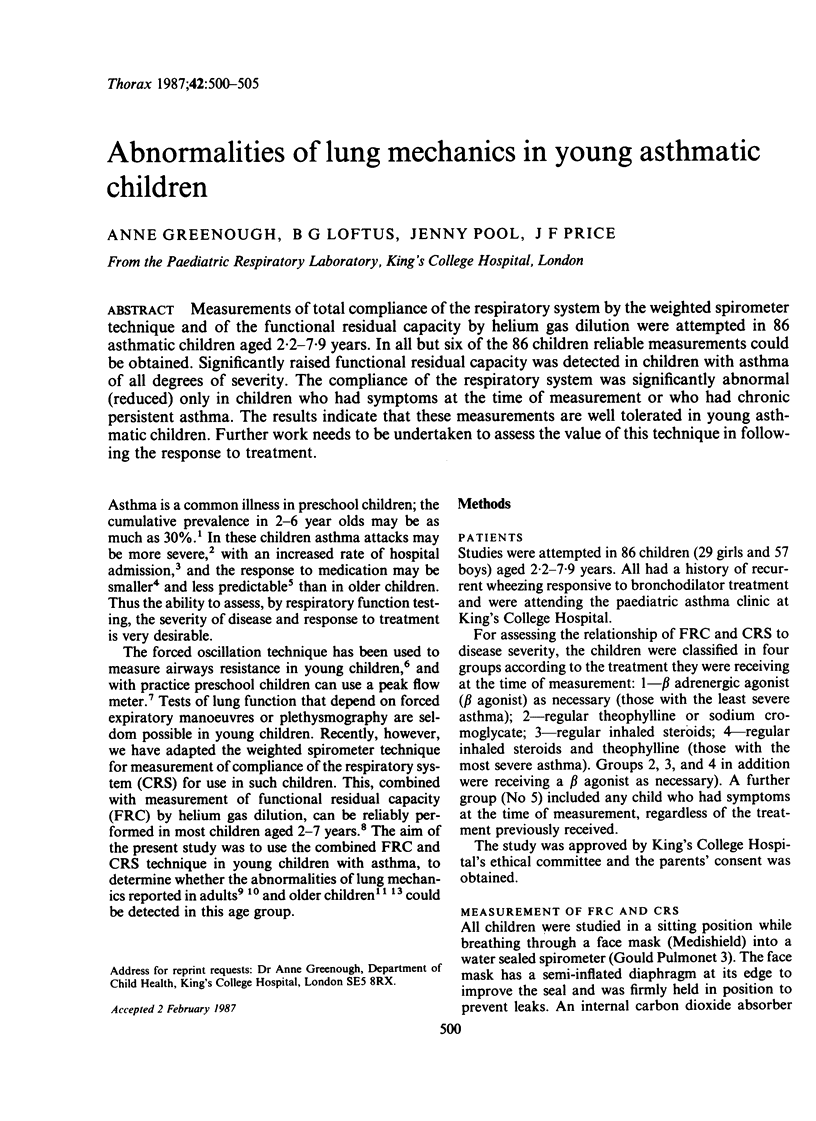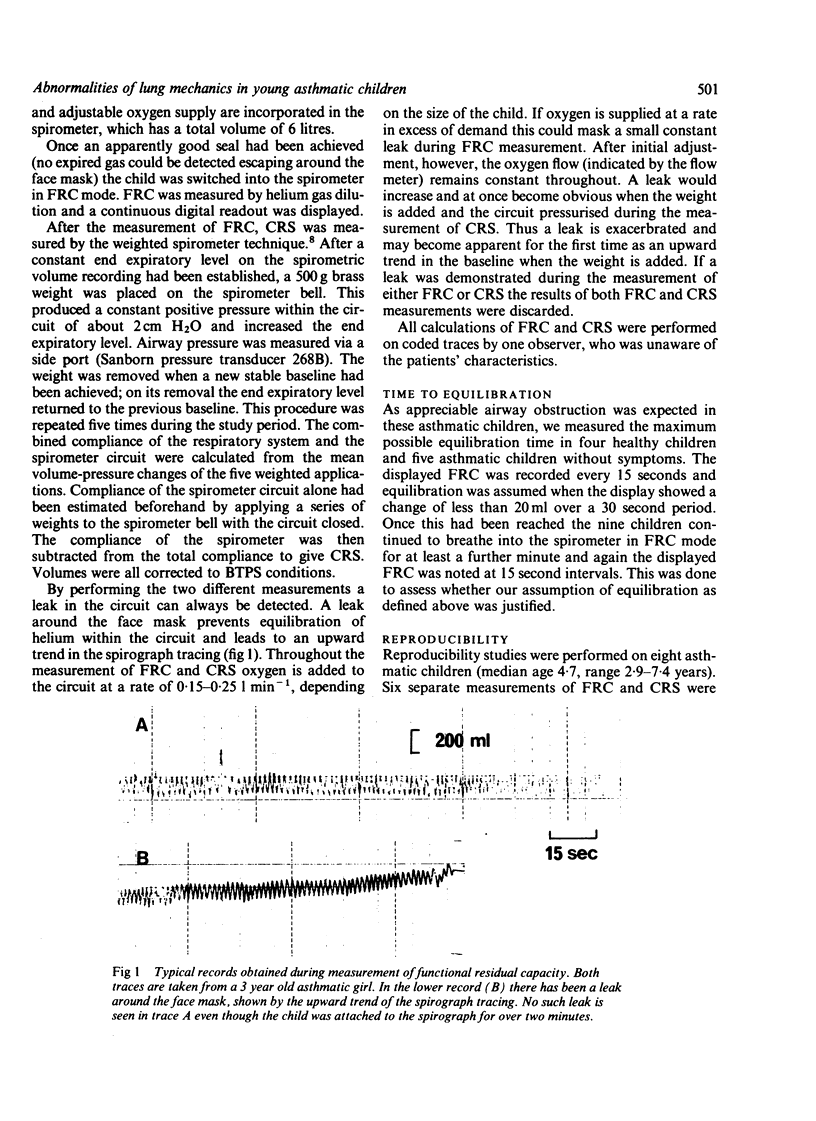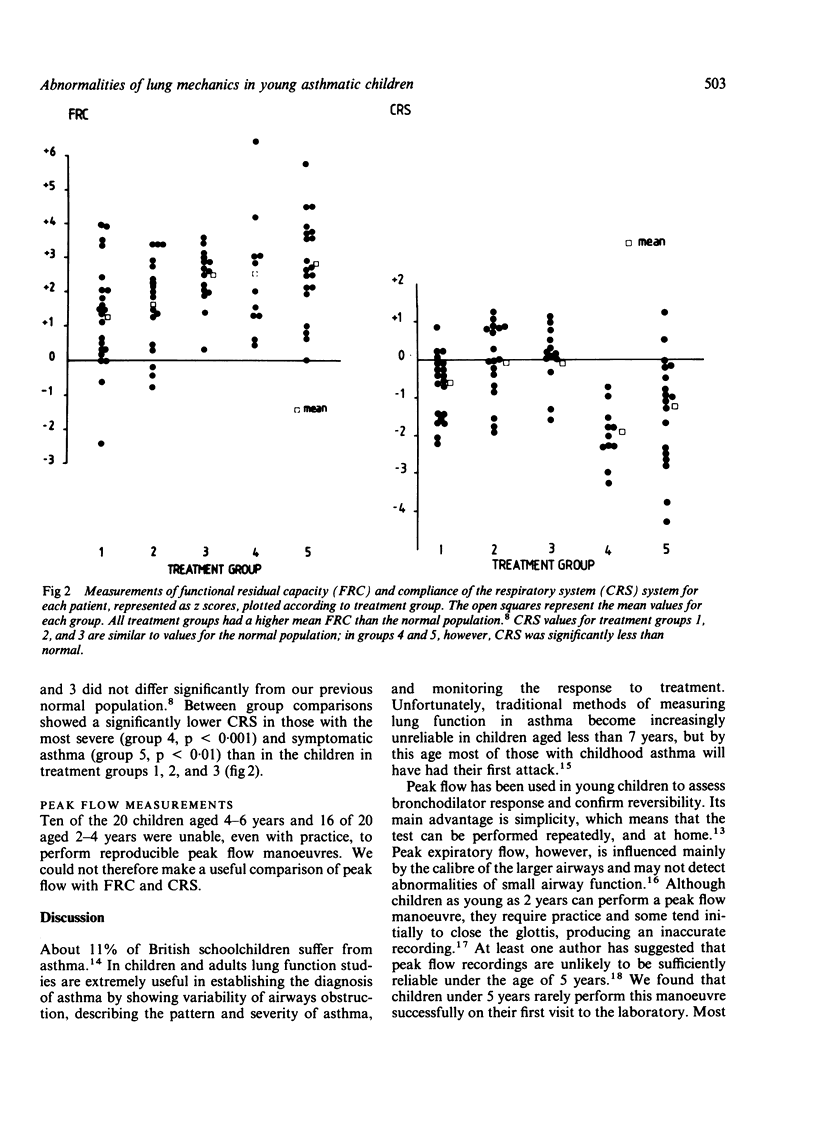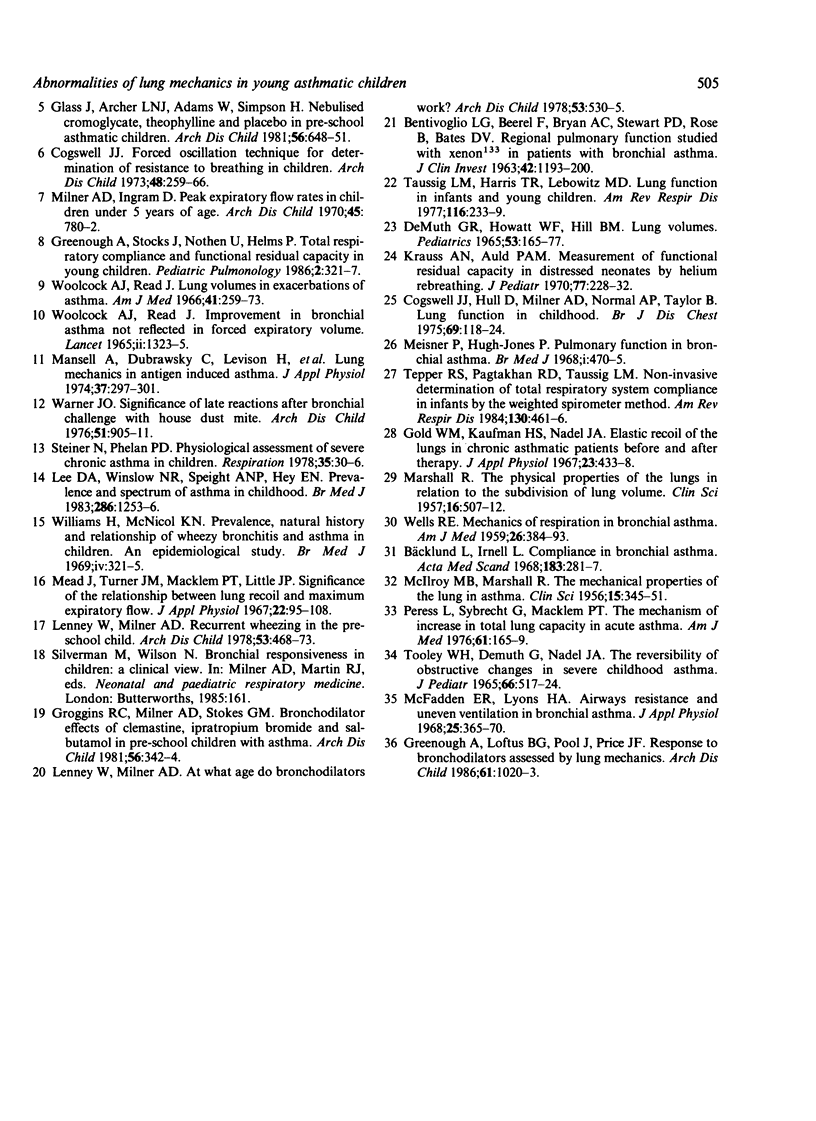Abstract
Measurements of total compliance of the respiratory system by the weighted spirometer technique and of the functional residual capacity by helium gas dilution were attempted in 86 asthmatic children aged 2.2-7.9 years. In all but six of the 86 children reliable measurements could be obtained. Significantly raised functional residual capacity was detected in children with asthma of all degrees of severity. The compliance of the respiratory system was significantly abnormal (reduced) only in children who had symptoms at the time of measurement or who had chronic persistent asthma. The results indicate that these measurements are well tolerated in young asthmatic children. Further work needs to be undertaken to assess the value of this technique in following the response to treatment.
Full text
PDF





Selected References
These references are in PubMed. This may not be the complete list of references from this article.
- BENTIVOGLIO L. G., BEEREL F., BRYAN A. C., STEWART P. B., ROSE B., BATES D. V. REGIONAL PULMONARY FUNCTION STUDIED WITH XENON IN PATIENTS WITH BRONCHIAL ASTHMA. J Clin Invest. 1963 Aug;42:1193–1200. doi: 10.1172/JCI104805. [DOI] [PMC free article] [PubMed] [Google Scholar]
- Bäcklund L., Irnell L. Compliance in bronchial asthma. Acta Med Scand. 1968 Mar;183(3):281–287. doi: 10.1111/j.0954-6820.1968.tb10478.x. [DOI] [PubMed] [Google Scholar]
- Cogswell J. J. Forced oscillation technique for determination of resistance to breathing in children. Arch Dis Child. 1973 Apr;48(4):259–266. doi: 10.1136/adc.48.4.259. [DOI] [PMC free article] [PubMed] [Google Scholar]
- Cogswell J. J., Hull D., Milner A. D., Norman A. P., Taylor B. Lung function in childhood. 2. Thoracic gas volumes and helium functional residual capacity measurements in healthy children. Br J Dis Chest. 1975 Apr;69(2):118–124. [PubMed] [Google Scholar]
- Gold W. M., Kaufman H. S., Nadel J. A. Elastic recoil of the lungs in chronic asthmatic patients before and after therapy. J Appl Physiol. 1967 Oct;23(4):433–438. doi: 10.1152/jappl.1967.23.4.433. [DOI] [PubMed] [Google Scholar]
- Greenough A., Loftus B. G., Pool J., Price J. F. Response to bronchodilators assessed by lung mechanics. Arch Dis Child. 1986 Oct;61(10):1020–1023. doi: 10.1136/adc.61.10.1020. [DOI] [PMC free article] [PubMed] [Google Scholar]
- Greenough A., Stocks J., Nothen U., Helms P. Total respiratory compliance and functional residual capacity in young children. Pediatr Pulmonol. 1986 Nov-Dec;2(6):321–326. doi: 10.1002/ppul.1950020602. [DOI] [PubMed] [Google Scholar]
- Groggins R. C., Milner A. D., Stokes G. M. Bronchodilator effects of clemastine, ipratropium, bromide, and salbutamol in preschool children with asthma. Arch Dis Child. 1981 May;56(5):342–344. doi: 10.1136/adc.56.5.342. [DOI] [PMC free article] [PubMed] [Google Scholar]
- Khot A., Burn R., Evans N., Lenney C., Lenney W. Seasonal variation and time trends in childhood asthma in England and Wales 1975-81. Br Med J (Clin Res Ed) 1984 Jul 28;289(6439):235–237. doi: 10.1136/bmj.289.6439.235. [DOI] [PMC free article] [PubMed] [Google Scholar]
- Krauss A. N., Auld P. A. Measurement of functional residual capacity in distressed neonates by helium rebreathing. J Pediatr. 1970 Aug;77(2):228–232. doi: 10.1016/s0022-3476(70)80328-6. [DOI] [PubMed] [Google Scholar]
- Lenney W., Milner A. D. Recurrent wheezing in the preschool child. Arch Dis Child. 1978 Jun;53(6):468–473. doi: 10.1136/adc.53.6.468. [DOI] [PMC free article] [PubMed] [Google Scholar]
- MARSHALL R., MCILROY M. B. The mechanical properties of the lungs in asthma. Clin Sci. 1956 May;15(2):345–351. [PubMed] [Google Scholar]
- MARSHALL R. The physical properties of the lungs in relation to the subdivisions of lung volume. Clin Sci. 1957 Aug;16(3):507–515. [PubMed] [Google Scholar]
- Mansell A., Dubrawsky C., Levison H., Bryan A. C., Langer H., Collins-Williams C., Orange R. P. Lung mechanics in antigen-induced asthma. J Appl Physiol. 1974 Sep;37(3):297–301. doi: 10.1152/jappl.1974.37.3.297. [DOI] [PubMed] [Google Scholar]
- McKenzie S. A., Edmunds A. T., Godfrey S. Status asthmaticus in children: a one-year study. Arch Dis Child. 1979 Aug;54(8):581–586. doi: 10.1136/adc.54.8.581. [DOI] [PMC free article] [PubMed] [Google Scholar]
- Mead J., Turner J. M., Macklem P. T., Little J. B. Significance of the relationship between lung recoil and maximum expiratory flow. J Appl Physiol. 1967 Jan;22(1):95–108. doi: 10.1152/jappl.1967.22.1.95. [DOI] [PubMed] [Google Scholar]
- Meisner P., Hugh-Jones P. Pulmonary function in bronchial asthma. Br Med J. 1968 Feb 24;1(5590):470–475. doi: 10.1136/bmj.1.5590.470. [DOI] [PMC free article] [PubMed] [Google Scholar]
- Milner A. D., Ingram D. Peak expiratory flow rates in children under 5 years of age. Arch Dis Child. 1970 Dec;45(244):780–782. doi: 10.1136/adc.45.244.780. [DOI] [PMC free article] [PubMed] [Google Scholar]
- Pearce J. L., Wesley H. M. Children with asthma: will nebulised salbutamol reduce hospital admissions? Br Med J (Clin Res Ed) 1985 Feb 23;290(6468):595–597. doi: 10.1136/bmj.290.6468.595. [DOI] [PMC free article] [PubMed] [Google Scholar]
- Peress L., Sybrecht G., Macklem P. T. The mechanism of increase in total lung capacity during acute asthma. Am J Med. 1976 Aug;61(2):165–169. doi: 10.1016/0002-9343(76)90165-0. [DOI] [PubMed] [Google Scholar]
- Speight A. N., Lee D. A., Hey E. N. Underdiagnosis and undertreatment of asthma in childhood. Br Med J (Clin Res Ed) 1983 Apr 16;286(6373):1253–1256. doi: 10.1136/bmj.286.6373.1253. [DOI] [PMC free article] [PubMed] [Google Scholar]
- Steiner N., Phelan P. D. Physiological assessment of severe chronic asthma in children. Respiration. 1978;35(1):30–36. doi: 10.1159/000193856. [DOI] [PubMed] [Google Scholar]
- Strachan D. P. The prevalence and natural history of wheezing in early childhood. J R Coll Gen Pract. 1985 Apr;35(273):182–184. [PMC free article] [PubMed] [Google Scholar]
- TOOLEY W. H., DEMUTH G., NADEL J. A. THE REVERSIBILITY OF OBSTRUCTIVE CHANGES IN SEVERE CHILDHOOD ASTHMA. J Pediatr. 1965 Mar;66:517–524. doi: 10.1016/s0022-3476(65)80116-0. [DOI] [PubMed] [Google Scholar]
- Taussig L. M., Harris T. R., Lebowitz M. D. Lung function in infants and young children: functional residual capacity, tidal volume, and respiratory rats. Am Rev Respir Dis. 1977 Aug;116(2):233–239. doi: 10.1164/arrd.1977.116.2.233. [DOI] [PubMed] [Google Scholar]
- Tepper R. S., Pagtakhan R. D., Taussig L. M. Noninvasive determination of total respiratory system compliance in infants by the weighted-spirometer method. Am Rev Respir Dis. 1984 Sep;130(3):461–466. doi: 10.1164/arrd.1984.130.3.461. [DOI] [PubMed] [Google Scholar]
- WELLS R. E., Jr Mechanics of respiration in bronchial asthma. Am J Med. 1959 Mar;26(3):384–393. doi: 10.1016/0002-9343(59)90247-5. [DOI] [PubMed] [Google Scholar]
- Warner J. O. Significance of late reactions after bronchial challenge with house dust mite. Arch Dis Child. 1976 Dec;51(12):905–911. doi: 10.1136/adc.51.12.905. [DOI] [PMC free article] [PubMed] [Google Scholar]
- Williams H., McNicol K. N. Prevalence, natural history, and relationship of wheezy bronchitis and asthma in children. An epidemiological study. Br Med J. 1969 Nov 8;4(5679):321–325. doi: 10.1136/bmj.4.5679.321. [DOI] [PMC free article] [PubMed] [Google Scholar]
- Woolcock A. J., Read J. Improvement in bronchial asthma not reflected in forced expiratory volume. Lancet. 1965 Dec 25;2(7426):1323–1325. doi: 10.1016/s0140-6736(65)92343-3. [DOI] [PubMed] [Google Scholar]
- Woolcock A. J., Read J. Lung volumes in exacerbations of asthma. Am J Med. 1966 Aug;41(2):259–273. doi: 10.1016/0002-9343(66)90021-0. [DOI] [PubMed] [Google Scholar]


